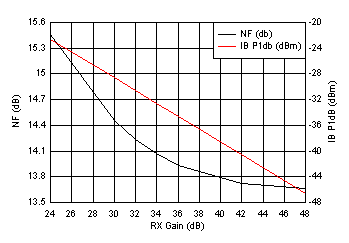SWRS211C May 2017 – October 2018 IWR1443
PRODUCTION DATA.
- 1Device Overview
- 2Revision History
- 3Device Comparison
- 4Terminal Configuration and Functions
-
5Specifications
- 5.1 Absolute Maximum Ratings
- 5.2 ESD Ratings
- 5.3 Power-On Hours (POH)
- 5.4 Recommended Operating Conditions
- 5.5 Power Supply Specifications
- 5.6 Power Consumption Summary
- 5.7 RF Specification
- 5.8 Thermal Resistance Characteristics for FCBGA Package [ABL0161]
- 5.9
Timing and Switching Characteristics
- 5.9.1 Power Supply Sequencing and Reset Timing
- 5.9.2 Synchronized Frame Triggering
- 5.9.3 Input Clocks and Oscillators
- 5.9.4 Multibuffered / Standard Serial Peripheral Interface (MibSPI)
- 5.9.5 LVDS Interface Configuration
- 5.9.6 General-Purpose Input/Output
- 5.9.7 Controller Area Network Interface (DCAN)
- 5.9.8 Serial Communication Interface (SCI)
- 5.9.9 Inter-Integrated Circuit Interface (I2C)
- 5.9.10 Quad Serial Peripheral Interface (QSPI)
- 5.9.11 JTAG Interface
- 5.9.12 Camera Serial Interface (CSI)
- 6Detailed Description
- 7Applications, Implementation, and Layout
- 8Device and Documentation Support
- 9Mechanical, Packaging, and Orderable Information
Package Options
Mechanical Data (Package|Pins)
- ABL|161
Thermal pad, mechanical data (Package|Pins)
Orderable Information
5.7 RF Specification
over recommended operating conditions (unless otherwise noted)| PARAMETER | MIN | TYP | MAX | UNIT | ||
|---|---|---|---|---|---|---|
| Receiver | Noise figure | 76 to 77 GHz | 14 | dB | ||
| 77 to 81 GHz | 15 | |||||
| 1-dB compression point(1) | –8 | dBm | ||||
| Maximum gain | 48 | dB | ||||
| Gain range | 24 | dB | ||||
| Gain step size | 2 | dB | ||||
| Image Rejection Ratio (IMRR) | 30 | dB | ||||
| IF bandwidth(2) | 15 | MHz | ||||
| A2D sampling rate (real) | 37.5 | Msps | ||||
| A2D sampling rate (complex) | 18.75 | Msps | ||||
| A2D resolution | 12 | Bits | ||||
| Return loss (S11) | –10 | dB | ||||
| Gain mismatch variation (over temperature) | ±0.5 | dB | ||||
| Phase mismatch variation (over temperature) | ±3 | ° | ||||
| In-band IIP2 | RX gain = 30dB
IF = 1.5, 2 MHz at –12 dBFS |
16 | dBm | |||
| Out-of-band IIP2 | RX gain = 24dB
IF = 10 kHz at -10dBm, 1.9 MHz at -30 dBm |
24 | dBm | |||
| Idle Channel Spurs | –90 | dBFS | ||||
| Transmitter | Output power | 12 | dBm | |||
| Amplitude noise | –145 | dBc/Hz | ||||
| Clock subsystem | Frequency range | 76 | 81 | GHz | ||
| Ramp rate | 100 | MHz/µs | ||||
| Phase noise at 1-MHz offset | 76 to 77 GHz | –95 | dBc/Hz | |||
| 77 to 81 GHz | –93 | |||||
(1) 1-dB Compression Point (Out Of Band) is measured by feed a Continuous wave Tone below the lowest HPF cut-off frequency (50 kHz).
(2) The analog IF stages include high-pass filtering, with two independently configurable first-order high-pass corner frequencies. The set of available HPF corners is summarized as follows:
The filtering performed by the digital baseband chain is targeted to provide:
| Available HPF Corner Frequencies (kHz) | |
| HPF1 | HPF2 |
| 175, 235, 350, 700 | 350, 700, 1400, 2800 |
- Less than ±0.5 dB pass-band ripple/droop, and
- Better than 60 dB anti-aliasing attenuation for any frequency that can alias back into the pass-band.
Figure 5-1 shows variations of noise figure and in-band P1dB parameters with respect to receiver gain programmed.
 Figure 5-1 Noise Figure, In-band P1dB vs Receiver Gain
Figure 5-1 Noise Figure, In-band P1dB vs Receiver Gain